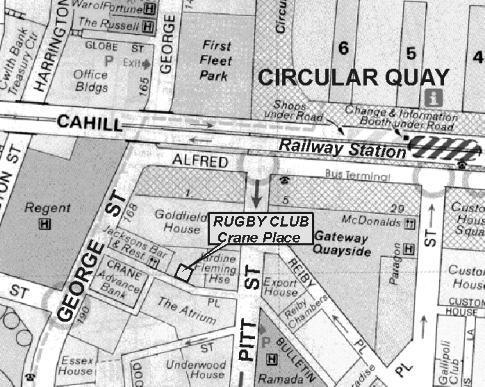
Rugby Club Location Map - Click to Enlarge
Thursday, 14th December, 2006. 5.30pm for 6pm
Rugby Club, Rugby Place, Circular Quay
Neil Wilkins
**********************
“The 400 year story of the Gold Ridge Discovery”
Shipborne prospecting activities began in the mid-16th century with the arrival of the first Mendana expendition from Peru, with gold being detected in several locations along the island arc including the Gold Ridge area on Guadalcanal. Other prospecting voyages up to the end of the 19th century met with violent ends in the form of mutinies and cannibalism.
The Japanese invasion in 1942 ended an attempt to scale up minor sluicing operations which began a few years earlier. Since that time evaluations by Emperor and CRA met with little success. CRA drilled five holes with only one positive result.
Amoco Solomons won a tender and negotiated a mining agreement allowing it to explore and possibly develop the property in 1982. I was the manager of the company from this time until 1986. The project had a number of problems that had to be overcome including the construction of a 20km jungle road, native title negotiations, threats by grafting politicians, earthquakes, cyclones, local training, and a 100% malaria rate.
During the discovery period over those years, over 100 core holes were drilled with more than 200 economic intersections, including many with high grades. Doubts about the recovery of oxide gold in the cores were resolved by the sinking of shafts, and an adit with a crosscut. Oxide grades were about twice the grade in core assays. Without this adjustment, the open ended bulk resource at that time was 27 million tonnes @ 1.76 g/t Au.
At the end of this period, a succession of corporate changes in the US and Australia led to the mismanagement of the project, and its subsequent loss. Upon development by Ross Mining, the mine, in its first year, produced over budget volumes of gold (about 160,000 ounces) from the Valehaichichi oxides. The operations then ceased due to the civil war on Guadalcanal.
The deposit is hosted by a waning high level hot spring system developed in Pliocene sediments with a strong volcanic component. It is part of a poorly explored belt of gold rich porphyry copper and epithermal mineral systems that lie along the margins of a Pliocene to Recent volcanic graben. The graben extends from Iron Bottom Sound across Guadalcanal into a flexure in the trench on the south side of the island. The lack of intrusives, structure, and higher temperature metallic phases, indicate that Gold Ridge is not located over a porphyry copper centre.
The dominant alteration is carbonate - clay - pyrite with only very minor quartz. At deeper levels the clay alteration gives way to chlorite. There are no intrusives other than rare pebble/breccia dykes, and there is only minor faulting in the flat-lying sequence of graded conglomerates, sandstones and siltstones.
In the upper and outer gold zones, the sulphide dominant mineralisation is strataform and stratabound as disseminations in fine carbonaceous silts and sands, whereas in the central and deeper levels, the gold tends to be free and coarse within quartz carbonate veinlets with a low sulphide content. Adularia is extremely rare, but there is a strong correlation between high grades of gold and organic material present as coal or bitumen.
Wikipedia - Guadalcanal********** Wikipedia - Solomon Islands

Rugby Club Location Map - Click to Enlarge